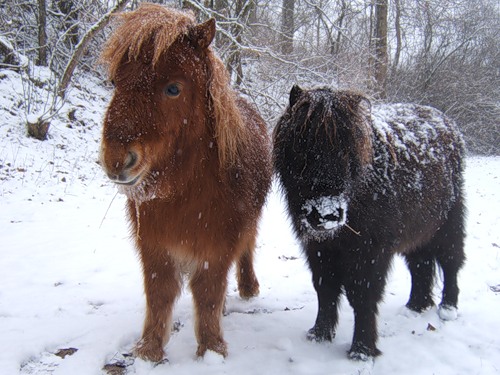
Pony(Equusferus pony Shetland)
Phylum —chordata
Class — mammalia
Order — perissodactyla
Family — equidae
Genus – equus
Appearance
Shetlands have small heads, sometimes with dished faces, widely spaced eyes and small and alert ears. The original breed has a short, muscular neck; a compact, stocky body; short, strong legs; and a shorter-than-normal cannon bone in relation to its size. A short broad back and deep girth are universal characteristics, as is a springy stride. Shetlands have long thick manes and tails and dense double winter coats to withstand harsh weather.Shetlands can be almost every colour, including skewbald and piebald (called pinto in the United States), but are mainly black, chestnut, bay, grey, palomino, dun, roan, cremello, and silver dapple.
The ponies range in height at the withers from approximately 70 cm (28 in) to a maximum of 107 cm (42 in).
Behavior
Shetland ponies are generally gentle, good-tempered, and very intelligent by nature. They make good children's ponies, and are sometimes noted for having a "brave" character. They can be very opinionated or "cheeky", and can be impatient, snappy, and sometimes become uncooperative. Due in part to their intelligence and size, they are easily spoiled and can be very headstrong if not well-trained.
Diet
For normal development, it is necessary to provide animals with a proper diet, which should be based on hay or pasture grass. It is undesirable to give oats to horses because of the risk of an allergic reaction.
Reproduction
Ponies breed in the same way as ordinary horses. Since the ponies are quite small, it is advisable to have experienced veterinarian examinations during childbirth. One or two foals are most often born.Selecting candidates for crossbreeding adhere to the general rules of breeding farm animals.
Many ponies are long-lived; it is not unusual for a Shetland pony to live more than 30 years.
Care
A Shetland pony will require the same basic grooming techniques as any other equine breed does. It includes washing, brushing, and combing regularly in order to keep the coat smooth, clean, and healthy. However, you should pay extra attention to a Shetland pony’s hooves, which will require daily care using a hoof pick and hoof brush to remove dirt, rocks, and other debris. This will ensure that there aren’t any injuries that need to be treated promptly.
Horses of this breed are quite demanding to harness, it requires a good fit to avoid chafing in places of contact with the body.
It is important to remember that shetland ponies are prone to overeating, so you need to carefully monitor the amount of food consumed by the horse, not allowing it to be overfed.
Due to the late formation of horses of this breed their arrival is possible only starting from the fourth year of life
 Russian
Russian
 English
English























